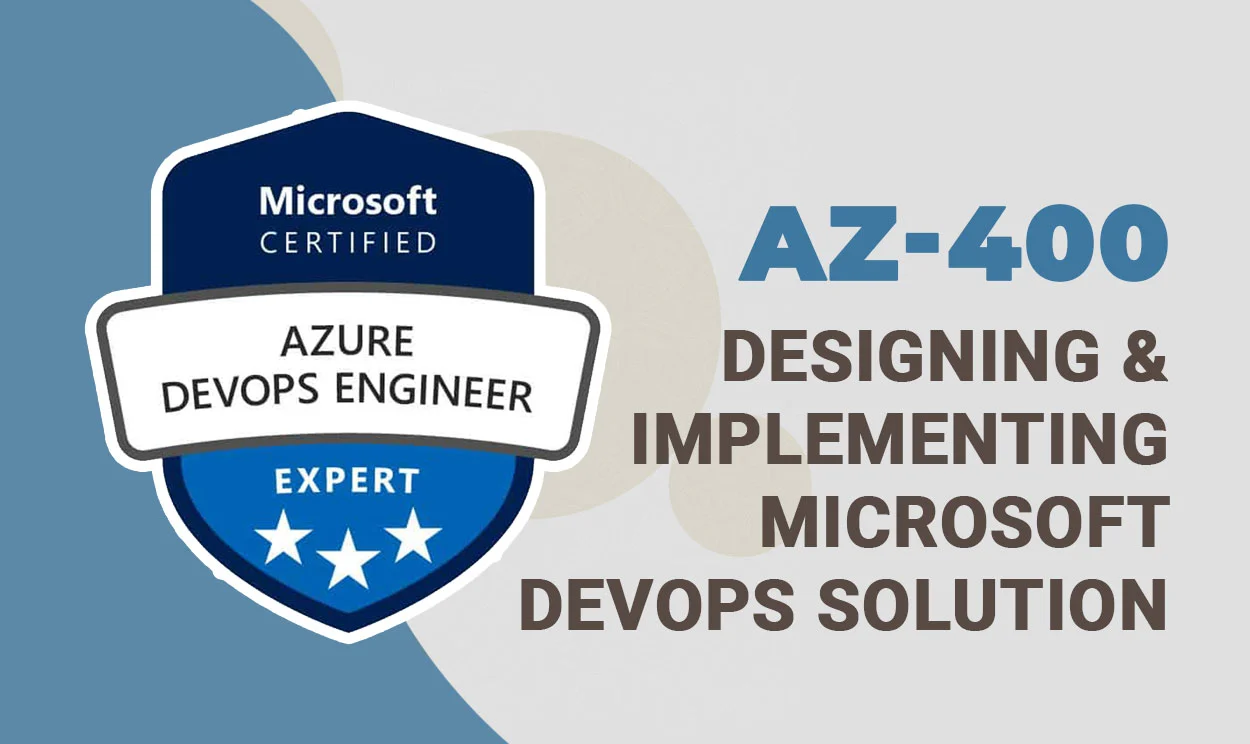AZ-400 Certification

About Course
The ability to deliver value quickly and reliably is a key differentiator in today’s fast-paced digital world. DevOps is the cultural and technical capability that enables this. The AZ-400: Designing and Implementing Microsoft DevOps Solutions certification establishes that you can combine people, processes and technologies to deliver value continuously. This is the credential for aspiring Microsoft Certified: DevOps Engineer Experts.
The SkillTech AZ-400 course is a deep-dive, hands-on experience intended for experienced professionals. You'll get a thorough Azure DevOps training experience in the entire lifecycle - from initial planning and source control, through building, testing and releasing applications with automated CI/CD pipelines. It is much more than exam prep; it is a masterclass in modern engineering.
The AZ 400 certification is one of the best Azure DevOps certifications you'll earn, as it proves you can design and implement a DevOps strategy to build and deliver better products faster.
What Will You Learn?
This expert-level course is Precisely designed to cover every domain of the AZ-400 exam, giving you the tools you need to lead a DevOps transformation. You will learn to:
Develop an Instrumentation and SRE Strategy
- Using Azure Monitor, design a thorough telemetry and monitoring plan.
- Implement Site Reliability Engineering (SRE) practices to enhance service reliability and performance.
- Develop a practical alerting strategy to proactively identify and resolve errors.
Manage Source Control and Implement CI/CD
- Implement and oversee source code branching techniques in GitHub and Azure Repositories.
- Using Azure Pipelines YAML, design and build reliable pipelines for Continuous Integration (CI) and Continuous Delivery (CD).
- Integrate security scanning and quality validation into your DevSecOps pipelines.
Design and Implement a Release Strategy
- Control release versioning, package management (Azure Artefacts), and build artifacts.
- Architect a release strategy by utilizing ideas such as release gates, deployment rings, and feature flags.
- Reduce downtime by implementing suitable deployment patterns (e.g., Blue-Green and Canary).
Implement Dependency Management and Infrastructure as Code (IaC)
- Utilize tools like Azure Artifacts and NuGet to manage program dependencies.
- Create and manage cloud infrastructure using ARM templates, Bicep, and Terraform.
- Using tools such as Azure App Configuration or Azure Key Vault to implement configuration management solutions.
Course Content
-
AZ-400 Introduction
08:59
-
Introduction of DevOps transformation journey
02:07 -
Introduction to DevOps
19:39 -
Choose the right project
09:23 -
Describe team structures
05:15 -
Choose the Devops tools
07:24 -
Plan Agile with GitHub projects and Azure boards
06:23 -
Introduction to source control
05:45 -
Describe types of source control systems
08:52 -
Work with Azure repos and GitHub
04:12 -
Labs
01:22
-
Introduction of development for enterprise DevOps
01:33 -
Structure your Git repo
02:38 -
Manage Git branches and workflows
05:49 -
Collaborate with pull request in Azure Repos
01:52 -
Explore Git hooks
02:11 -
Plan foster inner source
02:23 -
Manage Git repositories
04:33 -
Identify technical debt
10:39 -
Labs
00:41
-
Introduction of Implement CI with Azure pipelines and GitHub actions
02:42 -
Explore Azure Pipelines
06:38 -
Manage Azure Pipeline agents and pools
09:09 -
Describe pipelines and concurrency
08:22 -
Explore continuous integration
05:46 -
Implement a pipeline strategy
03:36 -
Integrate with Azure Pipelines
06:30 -
Introduction to GitHub Actions
08:24 -
Learn continuous integration with GitHub Actions
06:42 -
Design a container build strategy
11:14 -
Labs
01:45
-
Introduction of Design and implement a release strategy
02:22 -
Introduction to continuous delivery
08:56 -
Create a release pipeline
12:41 -
Explore release strategy recommendations
07:00 -
Provision and test environments
11:11 -
Manage and modularize tasks and templates
02:58 -
Multi-stage YAML
04:10 -
Automate inspection of health
08:54 -
Labs
00:41
-
Introduction of implement a secure continuous deployment using azure pipelines
01:47 -
Introduction to deployment patterns
05:26 -
Implement blue-green deployment and feature toggles
05:20 -
Implement canary releases and dark launching
03:58 -
Implement AB testing and progressive exposure deployment
03:27 -
Integrate with identity management systems
03:12 -
Manage application configuration data
10:01 -
Labs
01:13
-
Introduction of manage infrastructure as code using azure and DSC
01:18 -
Explore infrastructure as code and configuration management
06:12 -
Create Azure resources using Azure resource manager templates
06:30 -
Implement Bicep
06:49 -
Create Azure resources by using Azure CLI
02:53 -
Explore Azure Automation with DevOps
11:48 -
Implement desired state configuration DSC
07:51 -
Labs
00:42
-
Implement security and validate code bases for compliance
01:46 -
Introduction to Secure DevOps
10:47 -
Implement open-source software
08:02 -
Software Composition Analysis
07:21 -
Static analyzers
01:43 -
OWASP and Dynamic Analyzers
02:05 -
Security Monitoring and Governance
08:26 -
Labs
01:11
-
Introduction of Design and implement a dependency management strategy
01:11 -
Explore package dependencies
04:53 -
Understand package management
05:26 -
Migrate, consolidating and secure artifacts
04:11 -
Implement a versioning strategy
05:07 -
Introduction to GitHub Packages
04:24 -
Labs
00:35
-
Introduction to Implement continuous feedback
01:44 -
Implement tools to track usage and flow
07:25 -
Develop monitor and status dashboards
03:44 -
Share knowledge within teams
02:18 -
Design processes to automate application analytics
05:30 -
Manage alerts, Blameless retrospectives and a just culture
06:03 -
Discussion of Blameless retrospective
02:55 -
Labs
02:02